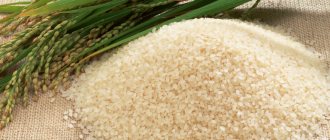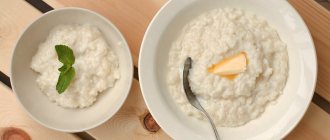The diet of a woman who is breastfeeding must be properly balanced and include only those components that are not capable of having a negative impact on both the woman and her baby. But not every nursing mother understands what food and in what culinary processing should be consumed, so they have a question: is it possible to eat various types of cabbage while breastfeeding?
Pediatricians and nutritionists do not recommend including this type of vegetable due to the presence of coarse, hard-to-digest fiber. This component requires a lot of protein molecules and enhanced digestive activity of the gastrointestinal tract in order to digest this vegetable. And this stimulates bloating.
No time to read? free list of allowed and prohibited foods during lactation
The benefits of white cabbage for breastfeeding
Cabbage, which ends up on a woman’s table when preparing her diet, can have a positive effect, but it is important to know and take into account the negative aspects. And skillfully bypass them. Then the benefits outweigh the negative impacts.
It is important to understand that the amount of vitamin C in it is greater than in other types of vegetables. And if it is impossible to include citrus fruits in the menu, it becomes a complete source of this substance.
In addition, it includes the full composition of micro- and macroelements, as well as vitamins necessary for the human body.
Vitamins and microelements contained in cabbage
Of all the vitamins in vegetables, vitamin C predominates. B, E and A are present in much smaller amounts.
Lots of elements, especially boron and potassium. These components help:
- establish the proper development and functioning of blood vessels and the heart, controlling the mode of contraction of this muscle;
- control the proper mineralization of bone tissue and the absorption of magnesium - which is important not only for the baby, but also for the mother’s skeleton;
- prevent a lack of vitamin D in the body, which prevents the development of rickets in the baby;
- maintain hormonal balance and prevent inflammatory processes.
Myth about the dangers of eating cabbage
Talking about the total harm of a vegetable for a woman in this state is clearly unprofessional. It is important to exclude it at a very early stage, when the child is still small, but over time, when the baby’s digestion becomes stronger, the mother, if desired, increases the amount of vegetables in the diet, but still does not make it a daily dish.
Knowing these rules, it becomes clear whether food prepared with this vegetable can be used in the diet of nursing mothers.
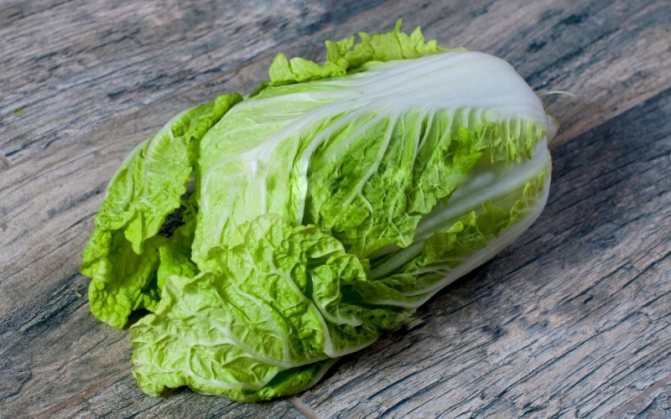
The effect of cabbage on lactation
Cabbage can affect the composition of breast milk as follows:
- Improve the quality of milk, making it nutritious and complete in bio-chemical composition.
- Provide your child with folic acid and vitamin C, which has the most positive effect on development and well-being. These components will help strengthen your immune system.
- As for the mother’s body, the introduction of a vegetable not only improves the menu and makes it varied, but also helps to cope with the problems in the bone structures that arise during the formation of the fetus and feeding the baby.
When a woman feeds her baby with milk, she is not allowed to eat everything, but cabbage should not be completely excluded from the diet. It is only important to include it in the dishes being prepared correctly and select the appropriate recipes.
If we talk about the effect on lactation, it is important to note the possibility of external use of the vegetable. If milk stagnation occurs in the breast, the so-called lactostasis effect, then one of the folk recipes is the effect of the juices in a cabbage leaf on the mammary gland. To do this, take one leaf, preferably not from the outside, but from the inner layers, knead it slightly and apply it to the inflamed area on the chest.
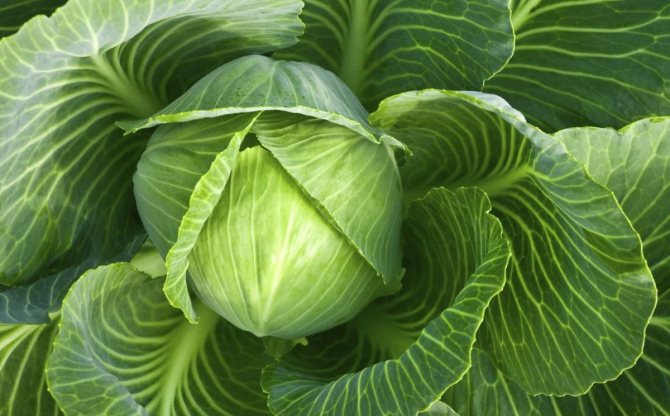
Possible effect on the baby
Cabbage dishes can be included in the diet of nursing mothers, taking into account certain features:
- Do this only when the baby reaches a certain age.
- All the time, in the first stages, monitor the child’s reaction - from his digestive system to various types of allergic reactions (urticaria, sinusitis, dermatitis, cough).
- You should not immediately associate discomfort in your baby’s tummy with eating the vegetable. Most often, all seething and gas formation is caused by an imbalance of beneficial bacteria in the large and small intestines.
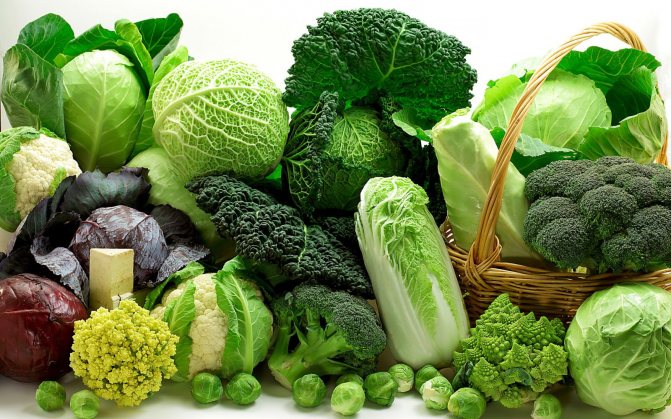
Pediatricians' opinion on cabbage consumption by nursing mothers
Is it allowed to eat this or that dish and how to prepare it correctly - these questions very often bother women, so they inquire about this from pediatricians.
Doctors, in turn, since this is a natural vegetable, recommend not completely excluding it from the diet. You just need to wait a little before using it in your diet and limit the amount of cabbage you eat within reason.
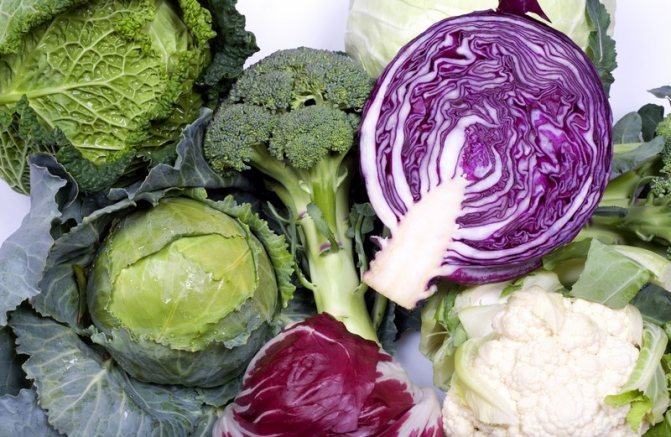
Fresh white cabbage: composition, beneficial properties
White cabbage is a biennial crop from the cruciferous family. This is one of the most widespread crops in Rus', which amazes with its combination of taste and nutrients that a healthy body needs. Also, this product is able to overcome various diseases, which has contributed to the enrichment of traditional medicine with numerous recipes since ancient times.
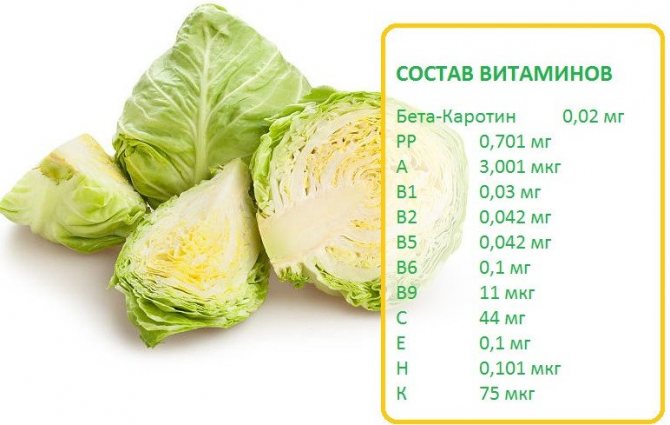
The nutritional value per 100 g of fresh vegetable leaves is as follows:
- carbohydrates -18.8 g;
- fats - 0.1 g;
- proteins - 7.2 g;
- calories - 28 kcal.
Also check out the benefits and harms of cabbage for the body.
The product is also rich in the following various vitamins:
- vitamin A - 2 mcg;
- vitamin C - 45 mg;
- vitamin E - 0.1 mg;
- vitamin B1 - 0.03 mg;
- vitamin B2 - 0.04 mg;
- vitamin B6 - 0.1 mg;
- vitamin B9 - 22 mcg.
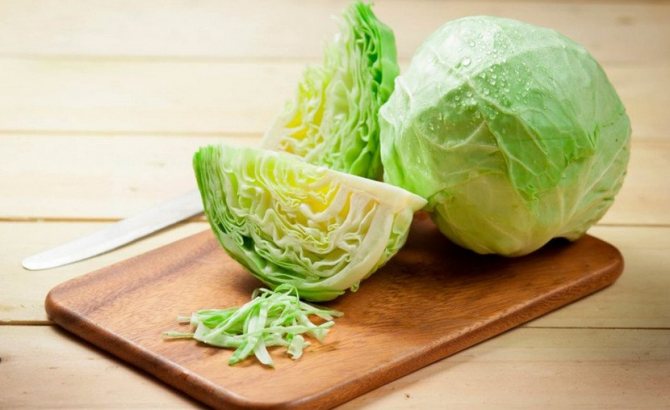
100 g of the product in question contains many useful microelements, the main of which are:
- boron - 200 mcg;
- potassium - 300 mg;
- calcium - 48 mg;
- sulfur - 37 mg;
- chlorine - 37 mg;
- phosphorus - 31 mg.
You might be wondering if you can eat cabbage before bed.
Each microelement contained in this vegetable has a positive effect on the functioning of individual organs and normalizes the condition of the body as a whole.
Doctors recommend consuming white cabbage because its biochemical composition affects the body in the following way:
- Calcium strengthens the skeleton and also has an anti-inflammatory effect.
- Zinc improves soft tissue regeneration and also helps prevent diabetes.
- Sulfur slows down the aging process and has an antiallergic effect.
- Potassium helps normalize heart rhythm.
- Magnesium regulates the functioning of the nervous system and also normalizes muscle activity.
- Iron strengthens the immune system and has an antibacterial effect.
- Iodine helps stimulate brain activity.
- Phosphorus is necessary for good growth of bone tissue and teeth.
- Folic acid is important for the rapid development of the body.
- Fructose helps stabilize blood sugar.
- Pantothenic acid is necessary for the formation of antibodies to strengthen the immune system.

White cabbage has many beneficial properties that are necessary for women:
- Tartanic acid, which is found in fresh cabbage leaves, prevents the deposition of fats under the skin, as this acid prevents the conversion of carbohydrates into fatty acids. Thus, this vegetable will be useful for women who are struggling with excess weight.
- The product in question also contains sulforaphane, which is an excellent prevention of the appearance of cancer cells in the mammary glands.
- Folic acid, which is contained in white cabbage, regenerates and renews body cells well, which helps maintain youthful skin and hair of women.
Did you know? Medical studies claim that eating white cabbage reduces the risk of cancer cells in the mammary glands by 15%.
- People have long used this product in folk medicine for the following medicinal purposes:
- elimination of pain in the joints and stomach;
- liver treatment;
- skin regeneration after burns;
- elimination of edema; treatment of diabetes;
- resumption of voice when it breaks down;
- treatment of bronchitis;
- improvement of skin condition.
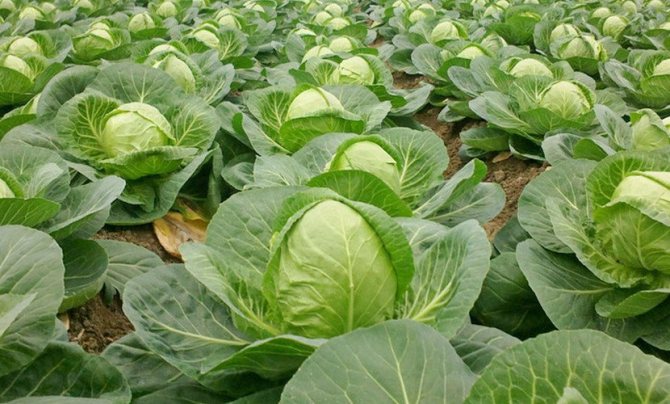
Rules for eating cabbage by a nursing mother
It is advisable to follow these rules:
- In an amount of 20-30 grams, it is permissible to add white cabbage to the mother’s menu only 50-60 days after the birth of the baby.
- Start administering with a volume of no more than 1 tablespoon, gradually increasing.
- It is best to include all new foods in the diet in the first half of the day.
- You should always monitor your baby's reaction after he has sucked milk.
But the cooking method also matters. So, if in a boiled state the vegetable is more comfortable for the stomach and intestines and causes less negative effects, then whether mother is allowed to eat fresh cabbage along with processed cabbage is worth thinking about.
To reduce the negative effect, doctors recommend squeezing juice from cabbage, diluting it with water in a ratio of 1:2 (that is, 1 part juice and 2 parts water) and drinking it like that. This way the woman receives all the benefits, excluding the negative impact of coarse fibers on her peristalsis. You need to drink juice from 50 g, increase slightly, by approximately 10 g. in several days. The total amount of juice should not be more than 100 grams. in diluted form.
Other species of the cruciferous family have no restrictions. Broccoli and cauliflower are not capable of negatively affecting mother and child. After all, by the way, these vegetables are among the first to be introduced even into a child’s complementary feeding. Mothers can start including them in their diet from the first weeks after birth.

Is it possible to have fresh cabbage while breastfeeding?
When fresh, the vegetable is the most difficult to digest. This is why nutritionists recommend:
- A woman can eat shredded fresh without fear approximately six months after she gave birth, but if desired, in small doses you can start after 4 days.
- Fresh leaves, intensively beaten, can be introduced into the diet from 3-4 months. Such mechanical processing significantly reduces the negative effects of fiber.
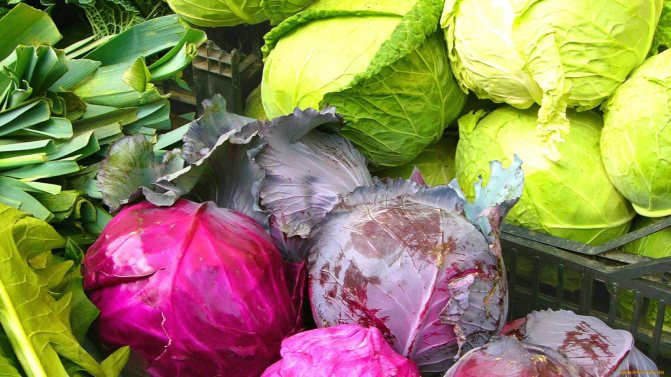
When can you eat white cabbage?
Here is when it is allowed to eat cabbage during breastfeeding, taking into account the cooking process and its type:
- Boiled white cabbage – from 2 months.
- Pickled and pickled - from 4-5.
- Stewed and fresh – from 6 months.
Remember that it is the consumption of fresh white cabbage that can cause the greatest negative effect to a woman and child.
Cabbage during breastfeeding in the first month
During this period, you need to be especially careful with the introduction of various new components. You can cook broccoli or cauliflower, but whether it’s worth the risk and eating the leaves is worth seriously thinking about and weighing all the pros and cons of doing this. It’s better to leave this for a later date.

Cabbage during breastfeeding at 2 months
When the baby is 2 months old, fresh cabbage can be introduced as an integral component of soups that the mother will eat while breastfeeding. Firstly, it is found there in small quantities, so you should not worry about its negative impact. Secondly, when boiled it is the least harmful.
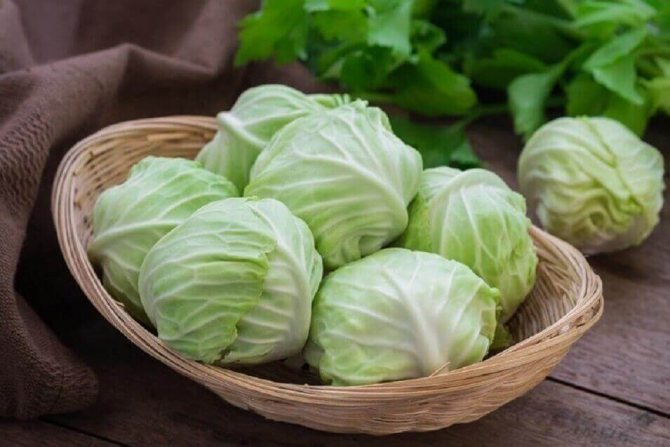
Eating cabbage in subsequent months
When the baby is completely grown up, women almost always have already introduced all the permitted products into their menu. This applies to all varieties. The baby gradually gets accustomed to a variety of food components.
It is also worth noting that by the time a woman plans to finish feeding her baby with her own milk, she has already introduced her little son or daughter to all the permitted foods in complementary foods. Therefore, everything becomes familiar and the harm from white cabbage during breastfeeding in this case is minimized. With the exception, perhaps, of those cases when there is individual intolerance of the body, manifested in the form of allergic reactions.
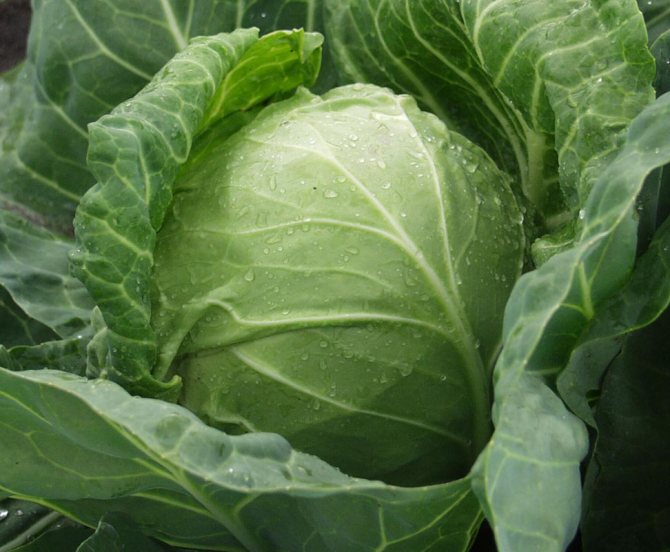
How to properly introduce cabbage into your diet
It is necessary to choose the right timing and periods, coordinating them with the baby’s well-being, when it is optimal to introduce and eat white cabbage into your menu. It is important to follow the following rules:
- The minimum amount is no more than 1 tablespoon in other dishes. And in a boiled state.
- Increase the total amount very slowly, allowing the volume to double over at least 2 weeks.
- After boiled vegetables, you can try dishes with baked cabbage.
- Then add fermented milk. Despite the apparent harm that this method of preparation can cause, this is not entirely true. The natural fermentation process in this dish produces a large number of enzymes and beneficial bacteria. They have the most beneficial effect not only on the digestive system, but also on other organs of the body.
- And only at the last stages should you eat stewed and raw cabbage.
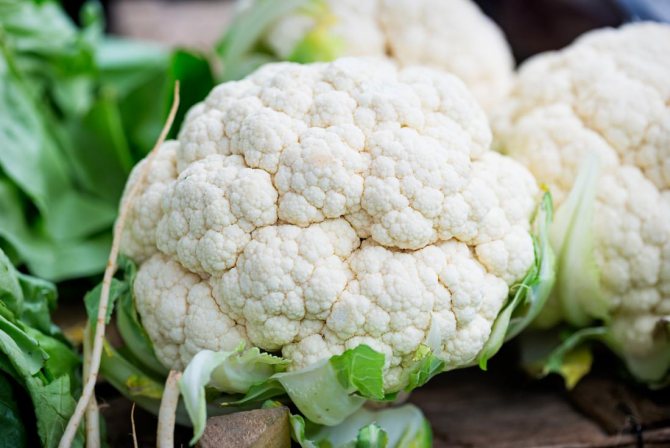
Rules for choosing cabbage for a nursing mother
It is very important to choose the right quality vegetable. Indeed, in addition to the negative effect of the biologically active substances included in cabbage, the chemicals that may appear in it after processing the plantings can have an extremely negative impact on both the mother and the baby. That's why:
- It is worth focusing on the vegetable that is grown with your own efforts. Only in this case can you be completely sure that the head of cabbage will not contain harmful components.
- If this is not possible, then you should buy cabbage based on its appearance. It should be smooth, round, without damaged parts. The cut of the stalk should be smooth, without sticky secretions and rotten areas.
- The outer leaves should be white. Their green color indicates that the vegetable has been exposed to sunlight and has accumulated harmful substances under their influence.
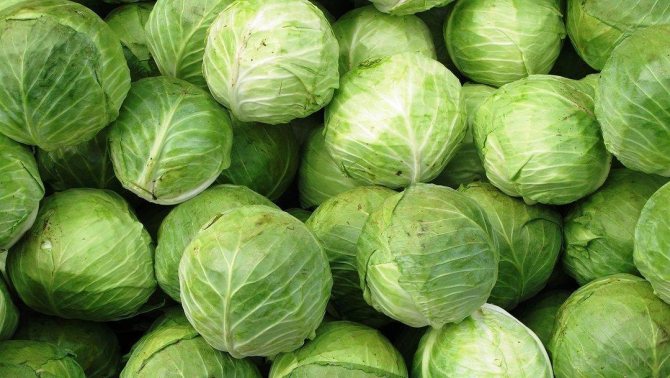
What's the best way to cook cabbage?
It is best to prepare vegetable soups at the beginning, to which you add cabbage in small quantities. You need to start with the very minimum, only gradually increasing the content.
At this stage you can prepare cabbage rolls. In any case, if the number of cabbage leaves seems too large, then you can not eat them all, but eat only the stuffing of the cabbage roll.
Then you can ferment it - it’s better to do this at home, observing all hygiene standards.
Stewing the vegetable and preparing a salad from it should be left for very late periods.
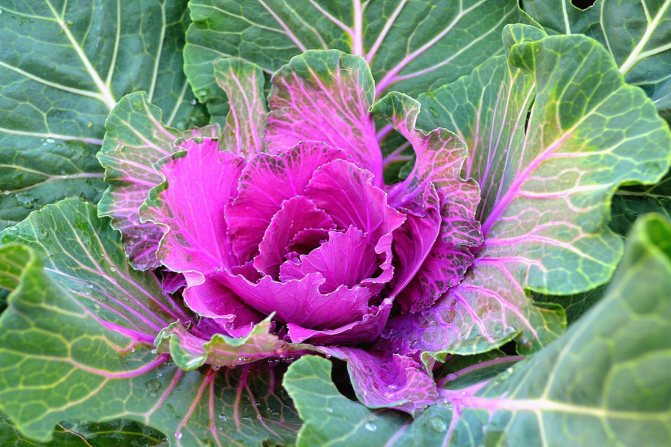
Cabbage during breastfeeding in the first month
The question of whether it is possible to eat cabbage while breastfeeding during colic is causing heated debate. There are no reliable facts confirming the relationship between the work of the child’s digestive tract and the mother’s nutrition. Therefore, cabbage cannot be considered the culprit of newborn flatulence.
The process of formation of intestinal microflora in a child is inevitably accompanied by gas formation. Even if a new mother refuses cabbage, this will not relieve the baby from colic. Whether to eat vegetables or not is a personal matter for every mother.
In the first month of a child’s life, doctors recommend avoiding consumption of any cabbage. Only at the end of 3 weeks are you allowed to introduce broccoli, cauliflower and Brussels sprouts into your diet in minimal portions. At the same time, it is necessary to monitor the baby’s reaction.
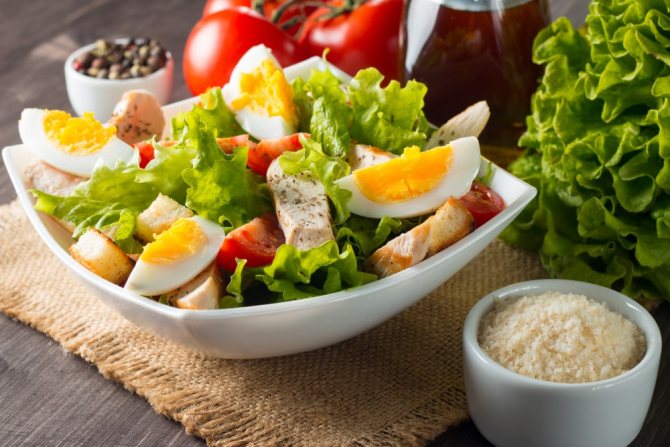
Cabbage dishes
The best dishes for women to consider are:
- Vegetable soup.
- Meat casserole with potatoes and cabbage.
- Cabbage juice (it is very important to note that it must be diluted with water).
- Stewed vegetables with meat - this also includes carrots, onions, broccoli or cauliflower, and white roots.
- Sauerkraut and pickled cabbage. But due to the fact that pickled milk may contain vinegar, it can only be eaten in the last stages, when the mother is already planning to complete feeding with her own milk.
- Fresh and stewed with vegetables should also be used in the menu at a later date.
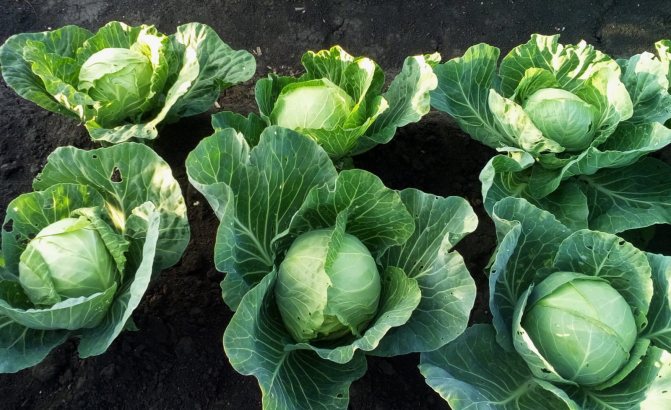
Is it possible for nursing mothers to have sauerkraut?
When fermenting cabbage, fermentation occurs, releasing a large amount of lactic acid. This product concentrates vitamins C and B, has anti-inflammatory and antibacterial properties.
However, such cabbage has a sharper taste, contains a lot of salt, and can cause heartburn even with normal stomach acidity.
Pediatricians advise including sauerkraut in the menu no earlier than from the 7th month of breastfeeding, when the baby’s enzymatic system is already formed and complementary feeding is provided.
Otherwise, the baby is likely to experience attacks of flatulence or loss of appetite.
Reviews from nursing mothers about eating cabbage
I used cabbage mainly in soups - it did not have a negative effect on my child. True, I tried to do everything correctly, introducing it gradually and only with gentle cooking.
Eating cabbage did not suit me or my daughter. The thing is that I myself don’t tolerate it very well. And after giving birth, she began to react even worse to her. Immediately after eating a small amount, I was bothered by a feeling of fullness in the solar plexus area. Therefore, I ate extremely rarely and in small quantities.
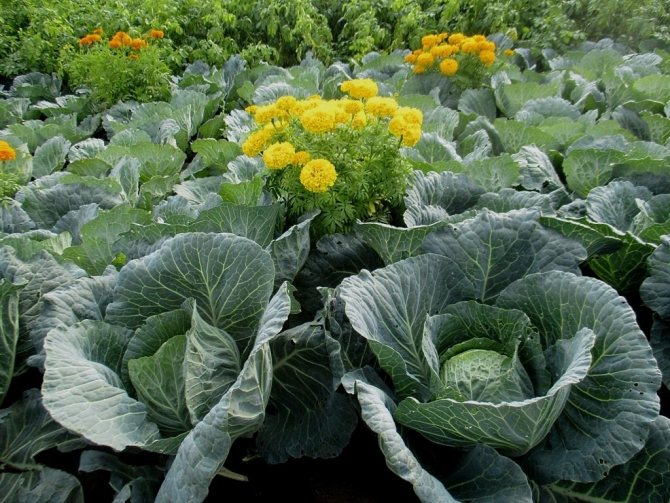
Thus, we can summarize that this vegetable crop will have a beneficial effect on the organisms of mother and child with the correct consumption regimen. It is worth choosing only high-quality products so as not to cause harm due to possible chemical components.
If there is any doubt, it is always better to consult a pediatrician about your diet and the effect on the baby.
Properties
Cabbage for breastfeeding is controversial, but it is important to know that the product itself is rich in a large amount of vitamins and microelements. This healthy fruit contains a lot of folic acid, as well as ascorbic acid, which is extremely beneficial for women's health.
The record amount of vitamin C in broccoli exceeds the composition of currants, oranges and lemons.
Seaweed is rich in iodine, which is necessary for the body during breastfeeding, which can affect the quality of blood, the growth and development of the child, the functioning of the stomach, the functioning of the heart, as well as the deposition of cholesterol in the arteries. Women who prefer seaweed as a salad or side dish have the opportunity to pamper themselves with the right dose of vitamin D. One hundred grams of kelp every day completely covers the need for iodine and other important elements.
If you have problems with the gastrointestinal tract, white cabbage is not recommended for use during breastfeeding on a daily basis. This is a heavy food for the stomach, which provokes fermentation, flatulence and pain. It is permissible to introduce such a vegetable only after 4-6 months, but a woman can use cabbage leaves for unexpected purposes.
If a girl is bothered by breast pain, swelling and pain during breastfeeding (often these are clear signs of lactostasis), compresses from the leaves can relieve unpleasant symptoms and help cope with the disease.
Recommendations for use.
- Introduce broccoli, cauliflower and Brussels sprouts from the first days after birth in boiled and stewed form. 1 month after birth, vegetables can be eaten fresh.
- Try one type of cabbage a day to monitor your baby’s reaction to a new product in the diet. If the baby has rashes, loose stools, he pulls his legs to his stomach and often cries, put the product aside for a month; the baby may have an intolerance to the substances contained in the vegetable.
- If a nursing mother’s body reacts to cabbage dishes with flatulence or loose stools, you should not eat them during breastfeeding: the baby will react with the same symptoms.
- Seaweed is a serious allergen. When breastfeeding, algae should be introduced gradually, starting with 30 g per day. If the child does not react negatively to this mother’s diet, you can enjoy seaweed, but no more than 150 g per day 3 times a week.
- Avoid sauerkraut, but if you really want it, eat more than 100 g of stewed cabbage.
- Fresh white cabbage should appear on the table of a nursing mother no earlier than the first month after birth. Until this time, it is worth eating it boiled, stewed or baked.
Cabbage in complementary foods - when to introduce?
Cruciferous vegetables are a source of beneficial micro and macroelements. They are easily absorbed by the baby's body and are suitable as the baby's first food.
- At 6 months, you can introduce your baby to broccoli or cauliflower puree, and from 8 months, offer him Brussels sprouts.
- Introduce white cabbage no earlier than 12 months: due to the coarse fiber, it is poorly absorbed by the intestines of a small person.
Delay introducing your child to sauerkraut and seaweed until he is 3 years old: the salt and spices in the marinade are not needed by the little person’s body.
Remember that the introduction of a new product into a child’s diet should be gradual. If signs of allergies and dyspeptic symptoms appear, stop offering a new treat and consult a doctor.
Products recommended for consumption
Allowed foods during breastfeeding are vegetables, cereals, lean meat, low-fat soups, cheese, boiled and baked fish. What is their use?
Vegetables
In the first weeks, it is recommended to eat raw vegetables with caution; it is better if they are boiled or stewed. Even when heat-treated, they are a source of vitamins and have a beneficial effect on the intestines.
Porridges are very filling and healthy, because a nursing mother needs a lot of energy! They contain slow carbohydrates, essential protein, vitamins and a whole range of minerals and trace elements.
Lean meat - boiled or baked beef, veal, rabbit
Birds are allowed only if they are domestic. Meat as a source of protein helps the body cope with stress and provides energy. A mother who is breastfeeding must consume 100 g of meat per day.
Low-fat soups. In the first months of a baby’s life, it is recommended to prepare vegetable soups using beef or lean pork broth. They should be present in the diet of a nursing mother due to the presence of proteins, iron, amino acids and microelements.
Cheese. This product contains calcium, which is so necessary for both mother and growing child.
Boiled and baked fish. Its benefit is that it is rich in protein and omega-3, -6 polyunsaturated fatty acids. Fish also contains phosphorus and iodine, B vitamins necessary for a nursing mother.
It is important!
The list of products during breastfeeding can be gradually increased. It is worth introducing fruits and other new dishes one product at a time, while observing the child’s reaction to updating the diet for several days.
If your baby is not allergic to cow's milk protein, you can consume dairy products. The same rule applies to other products: they can be introduced a little at a time, especially if the baby has already grown up. If you really want to eat a tangerine or orange, then you can afford a couple of slices. It’s still not worth limiting yourself in everything just because it may negatively affect the quality of milk. But we need to approach lifting restrictions wisely. You should gradually learn which foods will not cause a negative reaction in your baby while breastfeeding.
Proper nutrition for a nursing mother is very important to ensure that the baby receives as many essential substances as possible from mother's milk. And then breastfeeding will be beneficial for the baby, and will help the nursing mother enjoy her new role and realize the happiness of motherhood.
Kinds
The answer to the question whether a nursing mother can eat cabbage during lactation depends on the variety. There are several fruits with one common name: broccoli, cauliflower, sea broccoli, pickled broccoli, blue broccoli, cabbage broccoli. All varieties are very useful and diverse in their composition. It is important for a young mother to understand that not all varieties are ideal for consumption during breastfeeding.
Read also: Is it possible for a nursing mother to eat pork liver during breastfeeding?
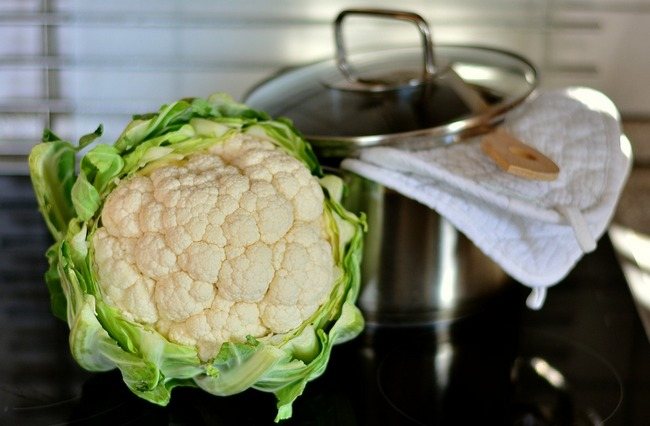
The choice is very wide and allows you to choose the appropriate option for preparing your favorite dish.
- Pickled. Salted leaves of the vegetable should absolutely not be consumed during lactation with breastfeeding. During preparation and preservation, large amounts of salt, spices, vinegar and oil are used. Such food is very dangerous and harmful to babies. Such a dish can even cause poisoning and problems with the gastrointestinal tract.
- Broccoli. Contains a record amount of vitamin C in its composition. A month after the birth of the baby, the time comes when you can eat such boiled cabbage while breastfeeding. You can make salads, casseroles and soups with the addition of boiled broccoli.
- Colored. Very useful inflorescences increase immunity, accelerate material metabolism, and cleanse the intestines of toxins. Doctors advise eating snow-white inflorescences boiled without adding spices during breastfeeding. It is allowed to be introduced into the daily menu two to three weeks after birth.
- White cabbage. It is strictly not recommended to eat it, especially raw. Such food can cause colic and flatulence in the baby. It is permissible to start eating it six months after the birth of the child, preferably stewed or boiled.
- Marine. Very useful for the child and mother, contains an impressive amount of vitamins, improves digestion and prevents anemia. The product is allowed to be eaten after three months from the start of lactation, but in small portions. Laminaria can cause an allergic reaction and this is worth remembering.
Step-by-step recipe for preparing stewed cabbage for nursing in a slow cooker
Ingredients
- Cabbage – half a head, 0.5 kg;
- Carrots – 1 pc.;
- Onion – 1 pc.;
- Water – 150 g;
- Salt.
Cooking method
- Thoroughly clean and rinse the vegetables with running water.
- Finely chop the white cabbage.
- We cut and remove the thick veins at the base of the head of cabbage.
- Grate the carrots.
- Cut the onion into half rings.
- Pour the vegetables into the multicooker bowl, mix with a silicone spatula, add salt, add water, mix again.
- Cook under the lid in the “Stew” mode for 20 minutes.
At the end of cooking, you can put 0.5 tsp in a container for taste. butter. This will add tenderness and a pleasant aroma.
Stewed cabbage according to this recipe in the first months of lactation can in no way harm a nursing mother and baby. This dish can be used as an independent dish or as a side dish for a cutlet, a piece of meat or liver.


